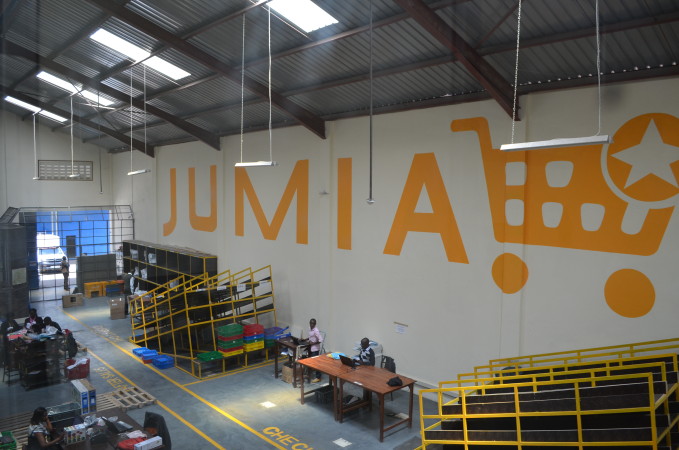Jumia Technologies AG (NYSE: JMIA) (Jumia or the Company) has announced its financial results for the quarter ended June 30, 2019.
We continue to deliver on our financial strategy of generating strong growth of our topline drivers, while accelerating monetization, driving cost efficiencies and developing JumiaPay. During the second quarter of 2019, our GMV increased by 69% year-on-year and our Gross profit grew by 94%.
Our Adjusted EBITDA loss as a percentage of GMV decreased by 562 basis points (5.62 percentage points) and our Operating loss, amounting to E66.7 million, decreased as a percentage of GMV by 148 basis points (1.48 percentage points) commented Sacha Poignonnec and Jeremy Hodara, co-CEOs of Jumia.
These results reflect our continued focus on offering a relevant and engaging online shopping and lifestyle destination for consumers, while providing our sellers with an attractive value proposition and a platform to grow their businesses. We remain focused on all aspects of our growth strategy, particularly JumiaPay, as we continue to drive its usage in our markets.
Business and Financial Highlights
- Growth momentum in topline drivers
- GMV increased this quarter by 69% compared to the second quarter of 2018, due to a variety of factors, including strong marketplace growth and robust consumer acquisition and re-engagement momentum.
- The number of Active Consumers at June 30, 2019 was 4.8 million, up from 3.2 million a year ago and 4.3 million at the end of the first quarter of 2019.
- These increases are a result of our continued focus on selection, price and convenience, as we strive to be the preferred online shopping destination for consumers in Africa for all their daily needs. During the second quarter of 2019, we continued to increase the assortment available on our platform and to engage with consumers through relevant local commercial campaigns such as our Mobile Week and Ramadan campaigns.
- Increased monetization
- In parallel with the strong increase in GMV and Active Consumers, Marketplace revenue increased by 90% compared to the second quarter of 2018 as we continued to drive monetization from diversified streams of revenue including Commissions, Fulfillment, Value Added Services and Marketing & Advertising services.
- Gross profit also grew faster than GMV, increasing by 94% compared to the second quarter of 2018, as a result of the increased monetization rate.
- We continued to drive monetization in a gradual manner, introducing attractive services to our sellers aimed at supporting the growth of their businesses. In the second quarter of 2019, we placed a particular focus on our Marketing & Advertising revenue stream by continuing to develop an attractive suite of marketing products. Marketing & Advertising revenue grew by 490% year over year and represented 8% of Marketplace revenue in the second quarter of 2019 compared to 2% of Marketplace revenue in the second quarter of 2018.
- Cost efficiencies
- We continued to balance strong growth with cost discipline. While delivering strong growth of our topline drivers GMV and Active Consumers, our Sales & Advertising expense as a percentage of GMV decreased by 76 basis points (bps), from 6.2% of GMV in the second quarter of 2018 to 5.4% in the second quarter of 2019, reflecting the strong Jumia brand awareness and attractiveness of our platform to consumers.
- Adjusted EBITDA loss as a percentage of GMV improved from negative 21.4% in the second quarter of 2018 to negative 15.8% in the second quarter of 2019.
- Development of JumiaPay
- JumiaPay remained a key focus area and it is now offered in six countries – Nigeria, Egypt, Ivory Coast, Ghana, Morocco and Kenya. Collectively, these six countries represented a combined population of almost 440 million people in 2018, according to data from the United Nations Population Division.
- We have also expanded the scope of JumiaPay beyond our physical goods marketplace. As of December 31, 2018, JumiaPay was only available within our physical goods marketplace. It is now also available within our on-demand services, Jumia Food, and hotel booking portals, Jumia Travel, in selected countries.
- Lastly, we continued to expand the range of financial and digital services available from third parties, powered by JumiaPay, offering our consumers an increasing range of relevant every day services. In Nigeria for instance, consumers can now access micro-loans offered by a local fintech startup, alongside event tickets offered by a local event ticketing provider. In Egypt, in the second quarter of 2019, we started distributing services from a local deals provider allowing consumers to purchase their vouchers on the Jumia platform, using JumiaPay.
Selected Operational KPIs
- GMV increased by 68.9% from €166 million in the second quarter of 2018 to €281 million in the second quarter of 2019, on the back of the growth of Active Consumers and spend per Active Consumer.
- The number of LTM Active Consumers as of June 30, 2019 was 4.8 million, up from 3.2 million a year ago and 4.3 million at the end of the first quarter of 2019. This corresponds to a quarterly net addition of 0.589 million consumers compared to a quarterly net addition of 0.211 million consumers over the same period last year. The acceleration in consumer growth is a reflection of the increasing relevance of our platform that drives continued consumer adoption and engagement.
Selected Financial Information
Revenue
The following table shows a breakdown of revenue, for the second quarters of 2018 and 2019.
- Marketplace revenue increased by 89.7% in the second quarter of 2019 compared to the second quarter of 2018, on the back of strong revenue growth across all components of Marketplace revenue, demonstrating our ability to monetize the platform as GMV and Active Consumers increase.
- Commissions, which are charged to our sellers, grew by 91.8%.
- Fulfillment, which are delivery fees charged to consumers, grew by 102.6%.
- Marketing & Advertising, which include performance marketing campaigns, or the placement of banners on our platform, grew by 489.5%. This strong growth was driven by an acceleration in brand marketing contributions, aimed at promoting the visibility of their products on our platform.
- Value Added Services, which include revenue from services charged to our sellers such as logistics services, packaging, or content creation, grew by 47.4%.
- First Party revenue increased by 39.2% in the second quarter of 2019 compared to the second quarter of 2018. We undertake our first party activity in an opportunistic manner to complement the breadth of product assortment on our platform, usually in areas where we see unmet consumer demand.
- Shifts in the mix between first party and marketplace activities trigger substantial variations in our Revenue as we record the full sales price net of returns as First Party revenue and only commissions and fees in the case of Marketplace revenue. Accordingly, we steer our operations not on the basis of our total Revenue, but rather on the basis of Gross profit, as changes between third-party and first-party sales mix are largely eliminated at the Gross profit level. Over time, it is our goal to reduce the proportion of first party activity in favor of third-party activity at group level. This strategy may however vary from quarter to quarter and from country to country.
Gross Profit
Gross profit increased by 93.6% from E8.9 million in the second quarter of 2018 to E417.3 million in the second quarter of 2019, as a result of increased platform monetization.
Fulfillment Expense
Fulfillment expense includes expenses related to services of third-party logistics providers, expenses related to our network of warehouses and pick-up stations, including employee benefit expenses. Fulfillment expense grew by 69.8% in the second quarter of 2019 compared to the second quarter of 2018.
Fulfillment expense is influenced by a number of factors including:
- The origin of the goods, for example the cost of shipping a product from a cross-border seller based overseas is higher than shipping from a local seller
- The destination of the package and type of delivery, for example main city vs. secondary city vs. rural area, and home delivery vs. pick-up station
- The type of goods, for example the cost of delivery is higher for a large home appliance than a fashion accessory
Sales & Advertising Expense
Our Sales & Advertising expense increased by 48.3% to E15.3 million in the second quarter of 2019 from E10.3 million in the second quarter of 2018, while we were able to increase our Active Consumers by 51.4% and our GMV by 68.9% over the same period. As a result, Sales & Advertising expense as a percentage of GMV, decreased from 6.2% in the second quarter of 2018 to 5.4% in the second quarter of 2019, demonstrating the relevance of our marketing strategy as well as the continued user adoption of our platform.
General and Administrative Expense, Technology and Content Expense
General and Administrative expense contains wages and benefits, including share-based payment expense of management, as well as seller management, commercial development, accounting and legal staff, consulting expense, audit expense, utilities cost, insurance and other overhead expense.
General and Administrative expense excluding SBC increased by 30.6% from E18.6 million in the second quarter of 2018 to E24.4 million in the second quarter of 2019. As a percentage of GMV, General and Administrative expense excluding SBC, decreased from 11.2% in the second quarter of 2018 to 8.7% in the second quarter of 2019 as a result of operating leverage.
Technology and Content expense increased by 22.8% from E5.4 million in the second quarter of 2018 to E6.7 million in the second quarter of 2019. As a percentage of GMV, Technology and Content expense decreased from 3.3% in the second quarter of 2018 to 2.4% in the second quarter of 2019.
Operating Loss and Adjusted EBITDA
Operating loss increased from E41.9 million in the second quarter of 2018 to E66.7 million in the second quarter of 2019 mainly due to an increase in SBC expense.
Adjusted EBITDA loss, as a percentage of GMV decreased from negative 21.4% in the second quarter of 2018 to negative 15.8% in the second quarter of 2019 as a result of a higher Gross profit margin as a percentage of GMV, marketing efficiencies and operating leverage improving General and Administrative and Technology and Content expenses as a percentage of GMV.
On January 1, 2019, we adopted IFRS 16 which changed the accounting for leases. This led to a reduction in General and Administrative expense by approximately E1.2 million in the second quarter of 2019, an increase in Depreciation and amortization by approximately E1 million and an increase in finance costs by approximately E0.3 million resulting in a positive impact on Adjusted EBITDA of approximately E1.2 million in the second quarter of 2019, a positive impact on Operating loss of E0.1 million and a negative impact on Net loss of E0.2 million. Prior period amounts were not retrospectively adjusted.
SBC expense amounted to E20.5 million this quarter. The increase in SBC expense during the second quarter of 2019 is mainly related to the Jumia Initial Public Offering, completed in April 2019, triggering the vesting of some of the stock options granted under the 2016 Stock Option Plan. The SBC expense of the second quarter of 2019 also takes into account the 2019 grants.
The following table summarizes the forecasts of SBC expense over the coming quarters, based on the amortization of the 2016 and 2019 grants.
Sales Practices Review
As disclosed in our prospectus dated April 11, 2019, we received information alleging that some of our independent sales consultants, members of our JForce program in Nigeria, may have engaged in improper sales practices. In response, we launched a review of sales practices covering all our countries of operation and data from January 1, 2017 to June 30, 2019.
In the course of this review, we identified several JForce agents and sellers who collaborated with employees in order to benefit from differences between commissions charged to sellers and higher commissions paid to JForce agents. The transactions in question generated approximately 1% of our GMV in each of 2018 and the first quarter of 2019 and had virtually no impact on our 2018 or 2019 financial statements. We have terminated the employees and JForce agents involved, removed the sellers implicated and implemented measures designed to prevent similar instances in the future. The review of this matter is closed.
More recently, we have also identified instances where improper orders were placed, including through the JForce program, and subsequently cancelled. Based on our findings to date, we believe that the transactions in question generated approximately 2% of our GMV in 2018, concentrated in the fourth quarter of 2018, approximately 4% in the first quarter of 2019 and approximately 0.1% in the second quarter of 2019. These 0.1% have already been adjusted for in the reported GMV figure for the second quarter of 2019. These transactions had no impact on our financial statements. We have suspended the employees involved pending the outcome of our review and are implementing measures designed to prevent similar instances in the future. We continue our review of this matter.
Legal Proceedings
Since May 2019, several class action lawsuits have been filed against us and certain of our officers in the U.S. District Court for the Southern District of New York and the Kings County Supreme Court in New York. The claims in these cases relate to alleged misstatements and omissions in our initial public offering prospectus and statements made by our company in connection with our initial public offering. These actions remain in their preliminary stages.














